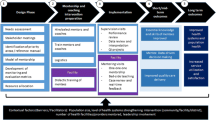Abstract
Objectives
To assess the partner graduation process used by SAT, the barriers partners face to graduation, and the outcomes following graduation, as well as to recommend directions for formalizing the graduation process into a more efficient and effective strategy.
Methods
The quantitative component of this evaluation described existing data on graduated partners. The qualitative component collected data through semi-structured interviews with SAT regional and national staff, and both current long-term and graduated partners, with an emphasis on SAT’s operations in Zambia and Zimbabwe. A participatory staff workshop allowed for the review of findings and recommendations.
Results
SAT has graduated 31 implementing partners in its 5 core programming countries, after an average partnership duration of 6.5 years each. The graduation process has generally operated in accordance with SAT’s guidelines regarding criteria and timeline, but has also involved considerable judgement, as SAT does not form explicit graduation strategies with partners. Key barriers to graduation included partners’ challenges with resource mobilization and high staff turnover, as well as the reduced clarity around the graduation process itself for both SAT staff and partners. The outcomes of the graduated partners interviewed revealed strong sustainability of organizational systems, but mixed sustainability of financial resources and resource-dependent features. SAT staff provided many recommendations for addressing partners’ challenges, and for improving and formalizing the graduation process.
Discussion
The efficiency and sustainability of SAT’s work could be improved with the development of an explicit and individualized graduation strategy with each partner. An enhanced and earlier focus on fundraising, sustainability, and human resources would also remove barriers to graduation and help improve outcomes.
Résumé
Objectifs
Évaluer le processus d’émancipation dont se sert le SAT à l’égard de ses partenaires, ainsi que les obstacles et les suites de cette émancipation, et recommander des moyens d’institutionnaliser le processus pour en améliorer l’efficacité et l’efficience.
Méthode
Le volet quantitatif de l’évaluation repose sur les données existantes fournies par les partenaires « émancipés ». Les données du volet qualitatif ont été recueillies à la faveur d’entretiens semi-structurés avec les effectifs régionaux et nationaux du SAT, les partenaires de longue date du SAT et les partenaires « émancipés » en Zambie et au Zimbabwe. Les constatations et les recommandations ont été étudiées lors d’un atelier participatif auquel étaient conviés les effectifs du SAT.
Résultats
Le SAT a émancipé 31 partenaires dans les cinq pays où il est présent; les partenariats ont duré en moyenne 6,5 ans chacun. En général, le processus d’émancipation se déroule conformément aux lignes directrices du SAT pour ce qui est des critères et des délais, mais il laisse une place considérable au bon jugement des intéressés, car le SAT n’établit pas de stratégie d’émancipation explicite avec ses partenaires. Les principaux obstacles à l’émancipation sont les difficultés des partenaires à mobiliser des ressources, le taux élevé de roulement du personnel et le manque de clarté du processus d’émancipation, tant pour le personnel que pour les partenaires du SAT. Les entretiens avec les partenaires « émancipés » montrent que les systèmes organisationnels mis en place durant le partenariat sont très durables, mais que les résultats sont plus mitigés en ce qui a trait à la durabilité des ressources financières et des activités qui en dépendent. Les effectifs du SAT ont formulé de nombreuses recommandations pour résoudre les difficultés des partenaires et pour améliorer et institutionnaliser le processus d’émancipation.
Analyse
On pourrait améliorer l’efficience et la durabilité du travail du SAT en élaborant une stratégie d’émancipation claire et individualisée avec chaque partenaire. Une attention plus poussée et plus précoce à la collecte de fonds, à la durabilité et aux ressources humaines abolirait aussi certains obstacles à l’émancipation et contribuerait à en améliorer les résultats.
Similar content being viewed by others
References
Gardner A, Greenblott K, Joubert E. What We Know About Exit Strategies: Practical Guidance for Developing Exit Strategies in the Field. Consortium for Southern Africa Food Security Emergency (C-SAFE), 2005.
Rogers BL, Macias KE. Program Graduation and Exit Strategies: Title II Program Experiences and Related Research. Washington, DC: Food and Nutrition Technical Assistance Project (FANTA), Academy for Educational Development (AED), 2004.
Swedish International Development Co-operation Agency (Sida), Department for Evaluation and Internal Audit. Exit Strategies–A Concept Note for a Joint Evaluation. Sida, 2005.
Hopps M. USAID Graduation: Sharpening the Policy on When and How to End Assistance. USAID Evaluation Highlights No. 65. Washington, DC: Center for Development Information and Evaluation, U.S. Agency for International Development (USAID), 1999.
World Food Programme (WFP). Exiting Emergencies: Programme Options for Transition from Emergency Response. WFP, 2004.
Southern African AIDS Trust. Overview of SAT Partnership Process. (Internal document)
Southern African AIDS Trust. Who is a SAT “Partner”? (Internal document)
Southern African AIDS Trust. SAT M&E Tools. (Internal document)
Southern African AIDS Trust. SAT Partner Monitoring Guidelines. (Internal document)
Centers for Disease Control and Prevention. Framework for program evaluation in public health. MMWR 1999;48 (No. RR-11):1–40.
Patton MQ. Utilization-Focused Evaluation: The New Century Text, 3rd ed. Thousand Oaks, CA: Sage Publications, Inc., 1997.
Patton MQ. Qualitative Research and Evaluation Methods, 3rd ed. Thousand Oaks, CA: Sage Publications, Inc., 2002.
Crabtree BF, Miller WL (Eds.). Doing Qualitative Research, 2nd ed. Thousand Oaks: Sage Publications, Inc., 1999.
Hope RA. Water, workfare and poverty: The impact of the Working for Water programme on rural poverty reduction. Environment, Development and Sustainability 2006;8:139–156.
Cromer C, Pandit T, Robertson J, Niewijk A. The Family Planning Graduation Experience: Lessons for the Future. Washington, DC: The Population Technical Assistance Project (POPTECH), 2004.
Maxwell D. Programmes in chronically vulnerable areas: Challenges and lessons learned. Disasters 1999;23(4):373–384.
Low W, Davenport E. NGO capacity building and sustainability in the Pacific. Asia Pacific Viewpoint 2002;43(3):367–379.
Author information
Authors and Affiliations
Corresponding author
Rights and permissions
About this article
Cite this article
Simon, L.D., Ismail, H. Southern African AIDS Trust: An Evaluation of the Process and Outcomes of Community-based Partner Graduation. Can J Public Health 99 (Suppl 1), S35–S41 (2008). https://doi.org/10.1007/BF03403795
Published:
Issue Date:
DOI: https://doi.org/10.1007/BF03403795



